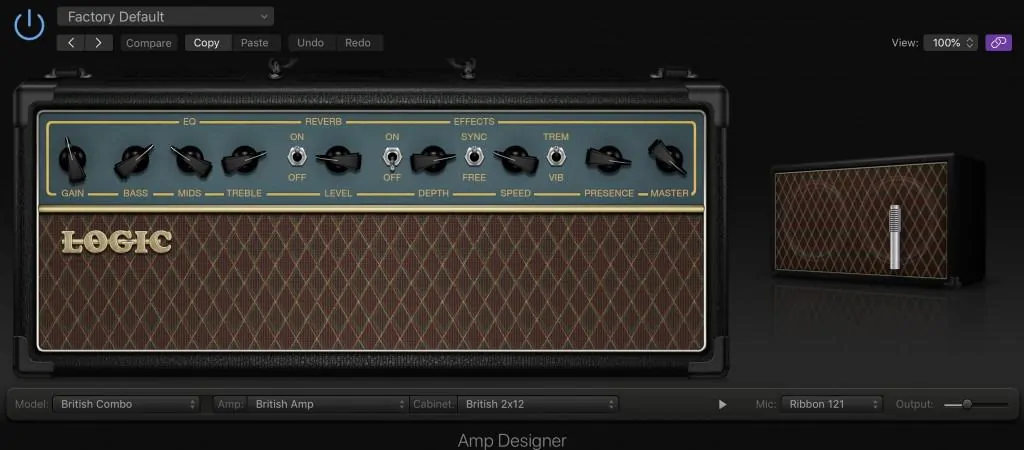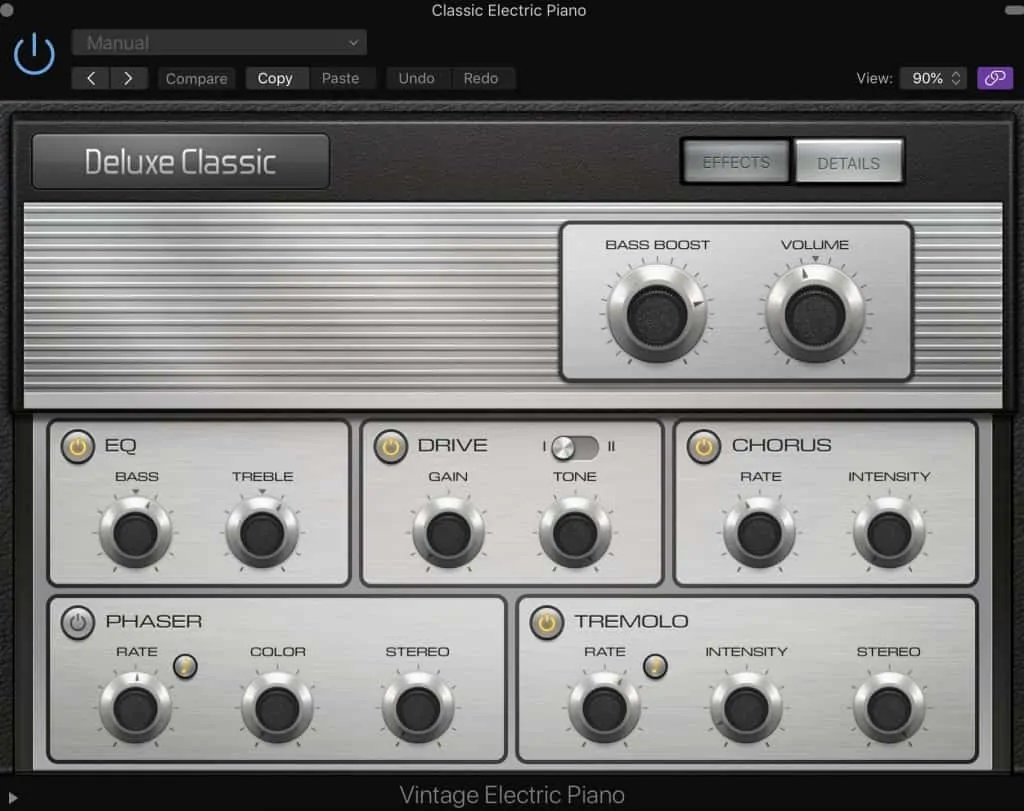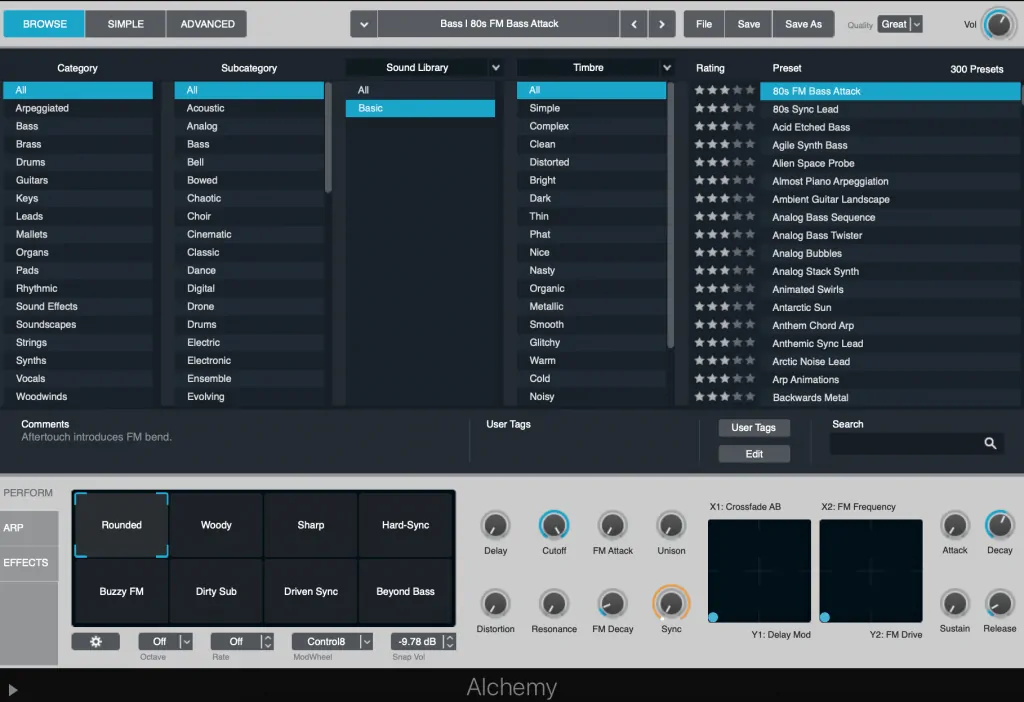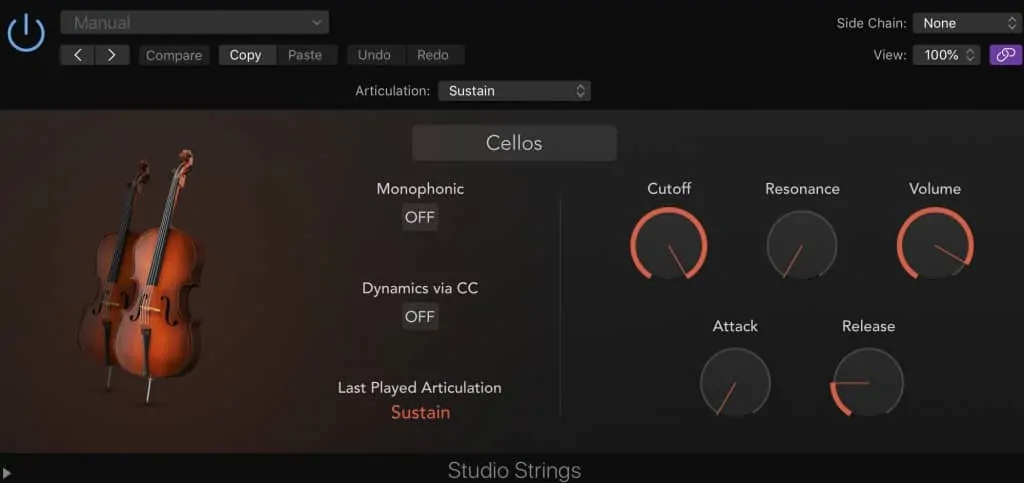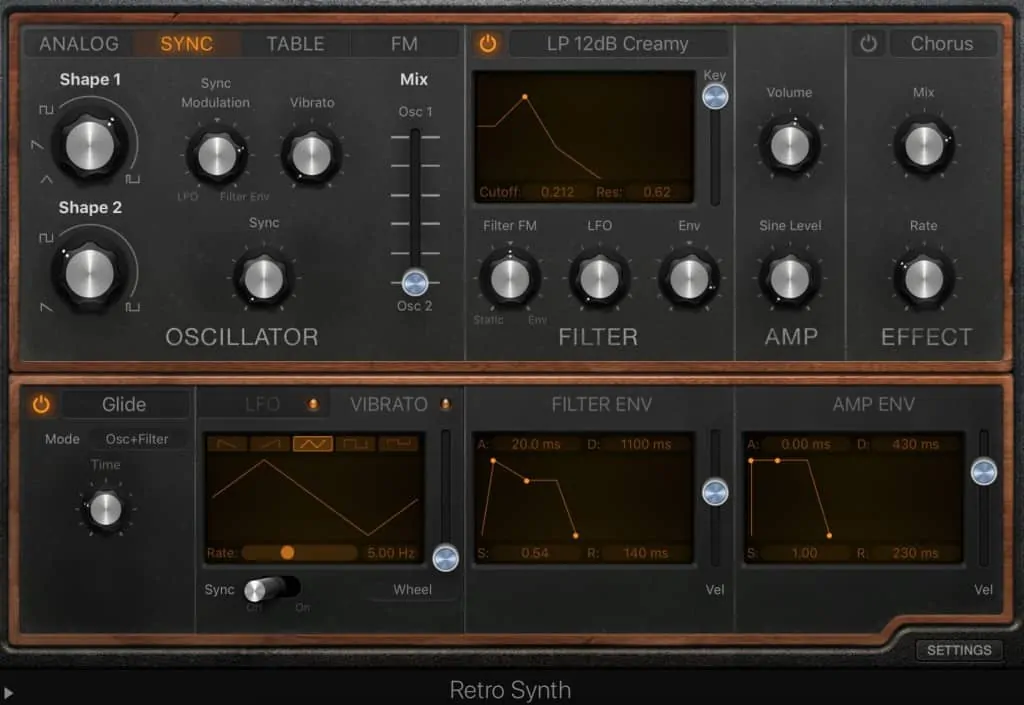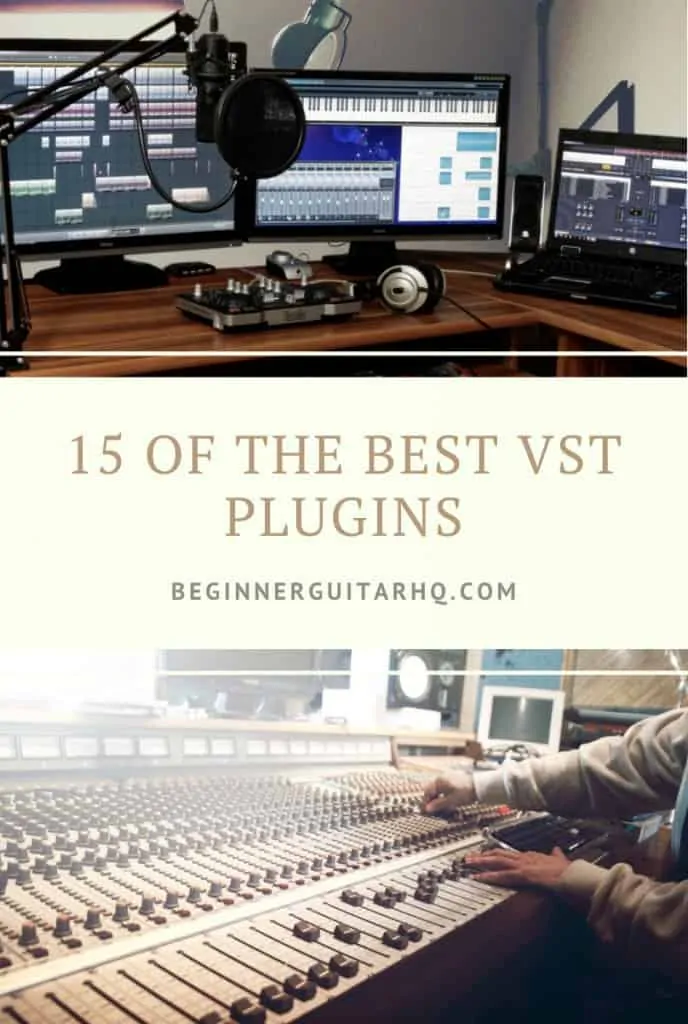At BeginnerGuitarHQ, we aim to help you learn to become a great guitarist. When recording and producing your own music, you’re pretty likely to encounter VST (Virtual Studio Technology) both in terms of creating instrumental sounds and timbres, as well as applying effects and manipulation to real, recorded instruments.
In this important guide, I’ll talk you through 15 of the best VSTs available to you.
If you’re looking to uncover some cool VSTs, then look no further…
First Things First
A VST is Virtual Studio Technology, an audio plug-in software which integrates software synthesisers and effects in DAW (Digital Audio Workstation). This means you can have instruments (such as samplers and MIDI) created within your DAW, some of which can be incredibly accurate and of high quality. You can create the sound and performance of an instrument without having to play the instrument. They’re a useful tool for anyone’s home studio.
Similarly, you can use VSTs to create effects that can be used to change the sound of live instruments you have recorded, or even the sound of the VST instruments you’re using. It’s important to understand that these plug-ins are all of very different quality, so I’ll talk you through some great and readily available VSTs. I’ll alternate between high quality VST’s available from external sources, and VSTs you can find that come with Logic Pro X for free.
Amp Designer
If you’ve got access to Logic Pro X, its likely you’ll be pretty familiar with Amp Designer. It’s a free plugin that comes built-in to Logic Pro X and offers a range of amp simulation sounds. It looks pretty basic and has the typical Logic layout, but with a little practice, you can really use it to your advantage.
Logic Pro X Screenshot Of Amp Designer
There are a few amp simulation sounds already built in, and let’s be honest, they aren’t brilliant. There are a few overdrive settings that give off pretty good results and can allow your DI’d guitar (or any other instrument if you’re feeling creative) to sound cool enough, but going manual is your best bet with this VST.
Of course, your natural response to creating a sure-fire success in your sound is to crank the overdrive to full; if you’re going full-metal, then this works a charm in Amp Designer. Similarly, an almost-clean sound will work well through here, especially if you’re just looking to give your dry signal a little treble boost or a bit more presence.
To get an edgier sound that falls somewhere in-between, a few tips to make the most of this VST include using some external effects before using this VST. If you go straight in there try and model using this, you may be a little disappointed- it’s free after all. You should also take advantage of the customisation options in this VST, such as the mic positioning (this is a great way to get a room sound that you might not have access to when recording) or play around with the types of speaker you can have the signal run through.
Trial and error is the way to go with this VST, as it can give you some really cool sounds when you layer things right and don’t rely on it as your only source of tone. Also, as with most VSTs, don’t use its effects settings. Make sure your reverb and tremolo etc. come from dedicated sources.
Xfer Serum
It may look a bit daunting from its huge frame and the detailed waveforms that sit at various positions around the screen while you have it open, but Xfer Serum is one of the most powerful and customisable wavetable synths you can access. It is so flexible that I reckon you can replicate basically any sound you wanted with the right knowhow.
The level of detail is incredible, and even though it looks like a lot, each section of design is actually quite easy to follow. You have the option to add sub-bass and noise to any sound, and not just add them, but customise their appearance. For example, the pitch, pan and phase. The oscillators have a visual appearance, with each one able to be positioned, detuned, phased and various other things, and your filters have much more detail than many of the default plug-ins.
Of course, at the bottom, you can design the entire sound of your synth, with envelopes and LFOs that can be changed through twisting knobs or editing a very easy to understand chart that positions everything exactly where you need. There are some good effects present and the ability to go into even more detail if you understand how (I don’t). This is one of those situations in which the digital option is better than basically every real-life synth you could get your hands on.
Bösendorfer Grand Piano
The Bösendorfer Grand Piano is actually a specific sound found within the Logic piano sounds VST, so it isn’t actually a VST in itself. However, I’ve pointed it out because I find it to be so much better than all of the other piano sounds available built into Logic. Of course, if you’re willing to spend, then you can get VSTs that basically sound 100% real, but for free, this sound is great.
Logic Pro X Screenshot Of Bosendorfer Piano
If you’re playing in through a MIDI keyboard, then you can get a surprisingly convincing sound from this setting. Add a little external reverb and make some good EQ choices and you’ll be on your way to a great sound. I’d be hesitant to suggest you use this setting to record a piece of solo jazz piano as it leaves it a little too exposed, but as a piece of accompaniment in hip-hop, for example, you can’t go wrong.
Sylenth 1
Sylenth claim to be able to match the quality of hardware synths in their software. It’s a big claim, but honestly, it might be a fair one. It isn’t exactly new, but has been receiving overwhelmingly positive reviews for over 10 years, so it is a trusted piece of kit in the world of audio production. Considering its advanced sound, the price tag is justified.
The sounds found within are all exceptional, with the pre-sets all giving a wide range of styles and timbres to use across a variety of genres. They’re rich in tone, and I suppose it is their dedication to be as high quality as hardware that gives them their characteristic warmth. They also feature some high quality emulations, such as of the MiniMoog and the TB-303 which don’t quite hold up to their real life counterparts but still hold relatively fair ground.
It’s so easy to use that despite its impressive ability to edit and manipulate sounds, it’ll be picked up in a heartbeat. You can go into detail with its envelopes, LFO manipulation and edit all the oscillators with ease. One of its most standout features, though, is its built in effects, which are actually really good. You don’t need to worry so much about pairing this with good VST effects, as there are dedicated effects that match the timbres perfectly already built in.
TAL-Reverb-III
The third version of the TAL-Reverb effects plugin has made sure to build on the missteps of previous versions and has created an incredibly dense and realistic plate reverb that can transform the sound of any other instrument.
It has a few pre-sets, but this reverb VST is much better used as a self-edited piece of software that you can learn to tame and employ for you own needs. Plate reverb is all it does, which means you’re getting a dedicated type of reverb, into a which a huge amount of effort has gone into making it as realistic as possible.
It works well, allowing you to get a detailed and realistic sound despite simple controls. You can edit room size, pre-delay, width and EQ the wet signal yourself. This means you can avoid pointless features that barely change the sound and instead focus on getting a cool sound that is simple to replicate each time you might need it.
Vintage Electric Piano
This is my personal favourite Logic VST as it houses the Classic Electric Piano sound as well as a few other brilliant jazzy keyboards. The Classic Electric Piano is absolutely as good a sound as any analogue keyboard and will have you well on your way to sounding just like Chick Corea in no time. There are a few other nice pre-sets as well, with the Bright Suitcase giving a unique sound and the Wurlitzer Modern taking an experimental route with a classic keyboard.
Logic Pro X Screenshot Of Vintage Electric Piano
You can edit your sound to exactly what you need through a genuinely nice looking, intuitive interface reminiscent of the 70s period from which this sound emerged. There is a simple EQ setting (which I don’t really recommend- you have access to much more detailed EQ elsewhere in Logic), a simple but effective overdrive setting, optional chorus, phaser and tremolo effects which are actually really good as they’re specific to this sound rather than a general effect that could be used on anything, as well as the ability to go into detail.
These details are where this VST really shines. You can make subtle pitch changes that will increase/decrease pitch by any number of cents, you can change how much notes can bend, as well as adjust the levels of bell and damper noise, and the balance of voices in the sound. This is the sort of easy to change details that every VST should have, as it allows you to create a truly unique sound worthy of professional recording.
Big Fish Vintage Strings
Synthesised strings are almost universally terrible, so focusing your search to samples is a wise move when trying to get a good string sound. Big Fish Vintage Strings is a collection of string sounds that truly transport us back to the golden era, replicating classic sounds of the 60s and 70s.
You’re treated to various very accurate and realistic patches that work perfectly in a classic soul/funk setting, with various levels of engagement based on your own skill level. You can, of course, arrange your own strings using your own skill and articulation choices. This gives you freedom, but also leave you at the mercy of your own arrangement and ability to play in good string parts.
You can also use assisted patches to generate harmony automatically. This means the programme will generate something that is bound to sound nice, simply because they know exactly how to make their programme sound as good as it can. This is a huge bonus to those just starting out, as it’ll give you some realistic and brilliant sounds with basically no work.
Waves GTR 3
Considering BeginnerGuitarHQ is first and foremost a guitar-based site, I thought I should draw your attention to the GTR 3 Plugin. It is a particularly high end, well-established amp emulator with the ability to be used in even the most professional of recording scenarios.
Waves GTR 3 has 19 amp models and 26 effects built into it, and even has a dedicated DI box that can be used to fit the plugin as much as possible (though it’s not necessary). There are even bass amp options. You can use the effects pedals as a signal chain just like you would in real life, which allows you to choose which wet signal effects which other wet signals. This means you have an incredible range of customisation on your tone which would be very expensive if all purchased as hardware.
As you may expect, you can edit the pre-sets to your own choosing, with the option to automate certain things such as dynamic, overdrive level and even real-time wah instead of the auto-wah that basically determines the amount of modulation based on how loud you play each note.
Alchemy
Alchemy is the classic Logic VST. It is a monster of a synth, with the ability to go into really complex detail that you really might not understand until you become a professional producer. The list of pre-sets is basically endless, using the browse function to bring up a setting by name, or use an advanced filter to find the type of sound you’re after.
Logic Pro X Screenshot Of Alchemy
For example, the Ambient Guitar Landscape, Evolving Currents and Music Vox can be found by name. As soon as you learn some of the names of your favourite sounds, you’ll know exactly where to find what you’re after; these three are up there with my favourites. If you don’t know the names, but you know the sort of sound you want, you can use a more advanced tool to locate them. This will split the sounds by category, subcategory and timbre, filtering out irrelevant sounds until you land on the one you’re after.
Then we can go further, and start to forge unique and original sounds. Clicking on the ‘advanced’ tab brings up a synthesiser you can customise all day long. It all looks a big daunting, but a user-friendly layout makes most of it quite easy to understand. You can bring in your own modulation settings and instruct them on exactly how to act, you can filter to various degrees, completely change the LFO of your entire sound and even use some particularly advanced production wizardry to incorporate arpeggiation, effects and different performance styles. Underneath all that, there are also some more general, wide-ranging things you can change at the touch of a button.
Toontrack EZDrummer
EZDrummer is known for its ability to craft realistic sounding drums when you don’t have access or the ability to record a real drum kit. For an amateur producer, recording a real kit is a challenge, so this VST is certainly worth the investment if you’re looking for professional sounding drums that only sound fake if you’re paying a ridiculous level of attention to the fills.
The best thing about EZDrummer is the visualisation of a drum kit that sits in front of you. You can add/take away cymbals and toms as you please, so whether looking for a tiny jazz kit or a huge metal beast, you can find something for you. As it’s a sampler, the sounds are all real and accurate to how they’d sound if you were playing a real kit; it’s a bit like someone has perfectly recorded a drum kit for you if you can’t do it yourself.
The sound quality is fantastic and the ability to play these samples in through a MIDI drum kit (if you have one) means you can create a near-perfect drum kit sound. There are pre-sets from Yamaha, Gretsch and Tama (and many more) which means you can even go right down to the specific sound you’re looking for. There are percussion options too, with cowbells and tambourines ready for use (though I always think a tambourine is one of the instruments you really need to record live to get a realistic sound).
The ‘EZ’ bit of the name is exactly that, and this VST offers a user-friendly experience which is so obvious in its methods that pretty much anyone could understand exactly how to get and change any sound they need. It’ll set you back a bit of money, but it’s definitely worth it to upgrade from the limited drum kit options Logic starts with.
Studio Strings
I’ll have to start the discussion of this particular VST by pointing out that there are much better string sounds available. The Big Fish Vintage Strings spoken about above are leagues ahead, for example, but there are certain times at which this free, very simple VST will do the job.
Logic Pro X Screenshot Of Studio Strings
In terms of creating/using the sounds offered, there isn’t much to offer in this simple plugin. You can change the articulation to be built around sustain or staccato etc. (I have some tips about that in a minute), while you’re able to change a few details like cutoff, resonance and attack, but beyond that, you’ll be relying on pre-sets and external effects to create the specific tone you’re looking for.
My tips when using this one: when you’re looking for some long, held pedal notes, it can work great. Hold a single long note with the sustain setting and you’ll get an accurate sound that can be pushed further by reverb and vibrato. Buried in a texture you’ll have no idea it isn’t real. Do not use the sustain setting when playing blocky string orchestral chords or lead lines, the VST isn’t very intuitive when it comes to changing notes and things won’t sound natural at all. If you need to change notes with your strings, make sure it’s a staccato melody line. That way, you don’t have to worry about the noticeable lack of ability to switch smoothly between notes.
Sonivox Wobble
The idea behind the Sonivox Wobble VST was to create a generator of dubstep sounds. As you might expect from that, it came out in the early 2010s. I don’t think it’s the most intuitive and brilliant VST of all time due to its limited editing options, but in a world lacking in software specifically for dubstep creators, it’s a powerful tool.
There are more than 200 pre-sets that allow for a brilliant sound to be generated, and each of these can be used as part of a pattern generator, meaning you don’t have to rely on playing in MIDI for the entire duration of a repetitive piece. Speaking of MIDI, you don’t typically associate dubstep to the playing in of music, but this piece of software is quite good at allowing some crazy, modern sounds to be just as cool when played directly in as when they’re generated.
Obviously, leads and basses are the most common here (just as they are in the genre) but once you get used to the software, you’ll be able to find some good middle ground filler.
Retro Synth
This one does exactly what it says on the tin. It creates Retro Synth sounds. In the Logic instrument selector, you’ll see the tab for ‘classic synths’; almost all of those pre-sets come from this VST. It looks the part, with a Moog inspired décor transporting you to the late 60s and the time of experimental music and prog.
Logic Pro X Screenshot Of Retro Synth
The pre-sets are great, especially when you’re looking to replicate some settings that might not even be physically possible to find these days. Obviously, no VST is going to be capable of replicating the hollow, retro sound of an analogue synth being played through a rumbling speaker cabinet, but this one gives it its best shot.
You have the ability to manipulate the sound exactly as you desire, with the ‘analog’ setting in the top left allowing you to choose waveforms to combine and the mix between the two sounds, while down below, you can edit the LFO to your hearts-desire. There are fine tuning elements as well, meaning you can make the setting you create stand out in the mix, while there are even a few effects options, though they aren’t the best.
FabFilter Pro C2
I’ve never really thought the need for hardware compressors or a particularly fancy compressor was a particularly important thing for a producer. They just compress the sound, right? Well, yeah, sort of. The FabFilter Pro C2 takes everything further, allowing you to not only get a distinctly nicer compression sound than those built into Logic, but it shows you everything in such a user-friendly way, that you actually start to understand what is happening to your sound.
Other than the 8 built-in compressor types, you can edit the impact of your compressor to various degrees. It depends on whether you’re just looking for a way of evening volume or you want creative changes. For example, the side chain triggering is a God-send for those crafting a heavy electronic drop.
The interface is primarily built on visuals and charts, which show exactly which element of the compressor is doing what and to what degree, as well as giving a visual representation of just how this is changing the sound. This is helpful, but also is a great tool in learning. Not only does it show what is happening, but by understanding what’s happening on a deeper level, you can start to use this knowledge to inform how you use compressors in the future.
Spectrasonics Omnisphere
I’m not sure to what degree the Omnisphere is regarded as a VST or an instrument, but maybe its both. The digital element of this product is a powerful collection of sounds (14,000 to be precise) that can be arpeggiated, edited and have effects thrown all over them. This alone means you can produce an exciting work through this VST.
However, it is the hardware element that really takes the Omnisphere to the next level. A huge orb with various shapes of button allows you to control whichever samples you programme to whichever button. This means that when you get used to where everything is, you’ll have control over a unique device that’ll allow you to perform a magically unique work.
Obviously, it’ll set you back a lot of money, but if you have the money and time to learn something very new, then this is a piece of kit that every produce should get a hold of at least once.
In Conclusion…
In this list, I’ve tried to point you towards free plugins and ones included for free in DAWs. There are various, arguably more advanced, VSTs which can cost a lot of money. However, if you’re open to spending the extra money, you can get some amazing replications of classic analogue effects, or some string sounds that sound like you have a live violinist in the room. Just remember that you don’t need to break the bank to get some cool virtual sounds.

